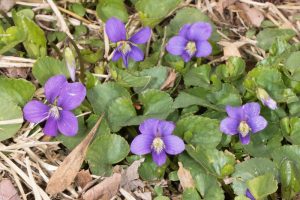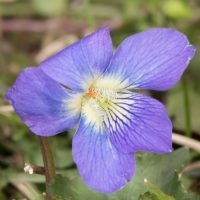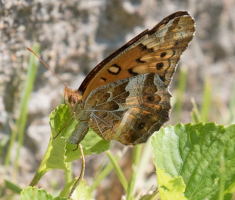Blog post and photos by Dawn Weber
Board Member-at-Large, Wild Ones – St. Louis Chapter
 With cold weather dragging on, I was in a funk. I NEEDED SPRING! I looked out and saw lots of purple violets and finally felt like spring was coming. I love the violets, even though they are considered to be a nuisance in the average lawn, and some consider them to be a weed due to their abundance and persistence. My goal is to convince you to spare the violets and let them be part of your landscape.
With cold weather dragging on, I was in a funk. I NEEDED SPRING! I looked out and saw lots of purple violets and finally felt like spring was coming. I love the violets, even though they are considered to be a nuisance in the average lawn, and some consider them to be a weed due to their abundance and persistence. My goal is to convince you to spare the violets and let them be part of your landscape.
Plant name:
Common blue violet (Viola sororia) even has the common name Missouri violet according to wildflower.org.
 Description:
Description:
In the spring, this plant has small purple flowers that are just 4-6 inches tall, with a 6-8 inch spread. The leaves are heart-shaped. A closer look shows quite a bit of color variation, which triggers discussion among experts as to whether there is one species with subspecies or even multiple species in what are labeled Viola sororia today.
During the summer, flowers without petals (called cleistogamous flowers) produce seeds that are flung outward from the seed capsules, the primary way that the plant spreads. It also spreads by rhizomes so a small clump will become a larger clump over time.
Why I chose this plant:
I didn’t choose this plant – it chose me – and has probably chosen you too!
 Why I let this plant exist in my space:
Why I let this plant exist in my space:
It is the host plant for the variegated fritillary butterfly (and other related butterflies) and 20+ species of other butterflies and moths.
Visitors:
The flowers are not popular with insects but they do sometimes attract skippers, flies, and bees. Ants have a special relationship with the violet, dispersing the seeds.
Environment:
Common blue violets prefer moist shady spots but seems to survive almost anywhere.
References:
Illinois Wildflowers
Missouri Botanical Garden


I’ve always thought these wild flowers are pretty and why not use them as a ground cover. Just because some people don’t care for them doesn’t mean you can’t.
Thank you for clarifying the value of the blue violet (aside from the visual pleasure they give us). I have always loved them and heard recently a discussion on how to rid one’s lawn of them on a Saturday morning talk show. Why why why???
Doug Tallamy told me a few years ago that the Common Blue Violet has all but disappeared in the East! Too many treated lawns and no more Fritillaries there. Violets, fragrant and edible, were my grandmother’s favorite flower. One of Nana’s earliest memories was picking them from a hillside covered with them and with butterflies. They were then painted with egg white, sugared and placed on tiny cakes or cookies and floated in tea for my great-grandmother’s friends. This was over a hundred years ago. I still pick them and fill tiny vases to enjoy their lovely scent and remind me of my Nana.
I too love the blue violet and welcome them to my yard.
Thanks for the reminders and additional info about violets, Dawn.
Last year I learned about the edibility of violet leaves and enjoyed them for the first time. The young, spring leaves are best. I’ll eat more in salads this year, but will still have plenty in my yard for the fritillaries and other insects!
FYI, I found this: Edible parts: Violet flowers and leaves are edible with the leaves having a high level of vitamins A and C. They can be used in salads or cooked as greens. The flowers can be made into jellies, candied, or tossed into a salad. http://www.ediblewildfood.com/wild-violet.aspx
Marsha, What is the flavor of the leaves? Do you mix them with other greens is a salad? Are they easily digested?
Thanks for this information Dawn! I love these violets and have been lobbying for others in my neighborhood to leave them. Now I have more information to use as the fuel of persuasion! I am going to try eating them this year too.
When I redid my very long and narrow side area, a few of these delightful flowers survived. I remember them from my childhood when we had white ones and even yellow ones down by the creek. Good memories. Shame they don’t last long enough, but I do enjoy them. Thanks for sharing,
Dawn!
They are all over our backyard too! Slowly coming to front where we have zoysia(planted by the first owner of our home). Have always loved violets…my mom would dig up some she found in the woods of our home to start in our yard. Love ’em! Thanks for the blog…
I love their purple splash of color! Who cares about lawns! I have dogs! Ginny J
My cousin scheduled her wedding in the spring so that she could carry a bouquet of common violets. I found they will tolerate mowing and survive hot, dry weather although they will turn yellow.
A low-growing native wildflower good for borders and edging (although they will not stay where you put them.)